What does lean-to conservatory mean?
A lean-to conservatory is a simple and cost-effective extension style that adds extra space to a home. Unlike larger extensions with double hipped roofs, a lean-to conservatory has a flatter, more slanted roof that rests at an angle between the roofline and the wall of the house.
This type of conservatory is typically square or rectangular in shape with a flat roof that slopes downwards, giving the impression that it leans against the house wall – hence the name “lean-to”.
How much does it cost to build a lean-to UK?
The cost of building a lean-to conservatory in the UK can vary depending on several factors, such as the size of the conservatory, the materials used, and the roofing options.
Generally, the cost of a lean-to conservatory can range from £7,000 to £15,000 before installation. However, when fully fitted, including the cost of conservatory, roofing, and installation, the price can range from £10,000 to £23,000.
The roofing material is a crucial consideration as there are three main options available, each with its own advantages, disadvantages, and costs.
These options include polycarbonate, glass, and solid tile roofs. The cost of a fully fitted uPVC lean-to conservatory, based on the roofing material chosen, can be estimated from the table provided above.
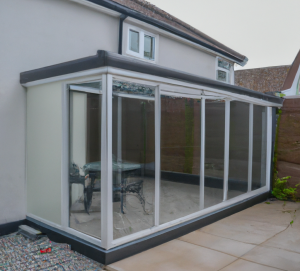
While the estimates are based on a standard 3m x 4m lean-to conservatory with dwarf walls, costs may vary depending on the installer and the specific project requirements.
Fully glazing the conservatory may result in lower upfront costs, but it is recommended to install it with dwarf walls for better thermal efficiency and energy cost savings in the long run.
It’s important to note that the prices provided are only estimates and seeking professional advice from a conservatory company is recommended for the fairest and most accurate cost estimates.
Overall, a lean-to conservatory is a cost-effective way to add extra space and value to a home, providing a bright and versatile living area for various purposes.
What is the difference between a conservatory and a lean-to?
A lean-to conservatory is perfect for homes with limited outdoor space. It has three sides and uses an existing exterior wall as the fourth side. Its rectangular shape and slightly sloping or flat roof ensure an unobstructed view from upstairs windows.
This conservatory is also suitable for properties with limited space under the eaves and can complement both modern and older homes.
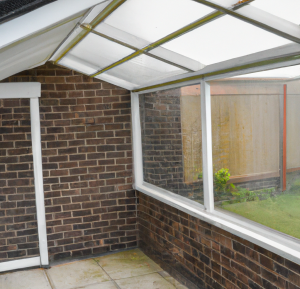
On the other hand, a conservatory can refer to different extension styles that feature a glass or polycarbonate roof and walls, allowing natural light to flood the room. While lean-to conservatories are a specific type, other conservatories may have varying shapes, sizes, and roof styles.
When deciding on a lean-to conservatory, it is best to seek advice from a professional who can help you select the best style for your home. For instance, if there’s space to the side and back of your home, an L-shaped conservatory could be a better option.
Do you need foundations for a lean-to conservatory?
Yes, you do need foundations for your conservatory, even if it’s lightweight. Adequate footing is essential to ensure safety and security. If your builder or glazier claims otherwise, it’s best to find another professional.
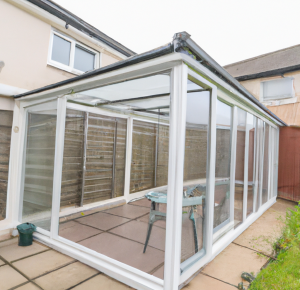
Groundwork can account for up to 30% of your total conservatory quote, but it’s a crucial investment in the longevity and stability of your dream extension. Make sure your conservatory has the best possible foundations to protect your investment.
Can you build a lean-to conservatory?
Certainly! Adding a lean-to conservatory can enhance the look of your home with its contemporary and sophisticated design.

The sleek lines and uncomplicated roof design make it an elegant addition. If you are considering building one, it is definitely worth exploring this option!
Do you need planning permission for a lean-to UK?
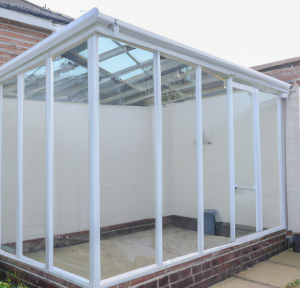
In the past, conservatories had to have a certain percentage of transparent roofing to be exempt from planning permission. However, recent changes in building regulations suggest that you may not need planning permission for a solid conservatory roof, regardless of the conservatory style you choose.
A lean-to conservatory, being smaller in size, usually does not require planning permission. However, if you plan to construct a gable-ended conservatory with a taller and steeper roof, you must verify that your plans adhere to building regulations.
Although planning permission is usually not required, if you want to replace a glazed roof with a solid roof, you will likely require approval from your local Building Control department.
This is because solid or tiled roofs are heavier than glazing, and you need to ensure that your lean-to conservatory can withstand the additional weight.
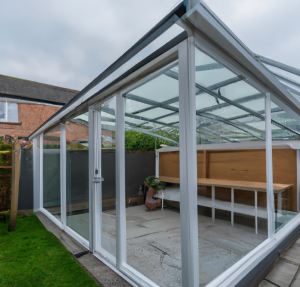
When constructing a lean-to conservatory with a solid roof, there are specific building regulations that you must consider. For example, your conservatory should be at ground level, less than 30 square meters, and must have a glazed external door connecting to your house.
If you are concerned about planning permission and your lean-to conservatory having a solid roof, several factors must be taken into account.
For instance, has your property undergone previous extensions, is it located in a conservation area or natural beauty spot, is your conservatory visible from the road or public right of way, or is your property listed?
If you answered yes to any of these questions, it is advisable to check with your local planning authority. This does not necessarily imply that you require planning permission, but it is better to be cautious.
Are lean-to conservatories any good?
Lean-to conservatories are a popular choice in the UK because of their contemporary design. With their slim aluminium frames and simplistic appearance, they have a modern and sleek look that can suit different home styles.
Unlike traditional conservatories that draw inspiration from Victorian or Georgian architecture, lean-to conservatories have a Mediterranean vibe.

They are particularly suitable for smaller properties and gardens since they take up less outdoor space and can have a low-pitched roof that works well with bungalows having low roof lines.
If you’re looking for an extension that is both fashionable and functional, then a lean-to conservatory is definitely worth considering.
What are the advantages of lean-to conservatory?
Lean-to conservatories offer several benefits to homeowners. Firstly, they are a cost-effective way to expand a home without sacrificing exterior space. Additionally, their adaptable style suits both traditional and contemporary homes, and their pitched roof can be adjusted to fit even in awkward spots.
The use of A+14 certified double-glazed glass can improve energy efficiency and save on utility bills.
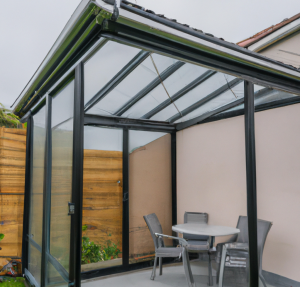
The simple yet intelligent design of lean-to conservatories offers flexible use of space, and their expansive panes of glass allow for an influx of natural light.
Finally, installing a lean-to conservatory can increase the value of a property, making it a wise investment for homeowners.
What are the disadvantages of lean-to conservatory?
Conservatories may pose some drawbacks if not designed properly. One of the main issues is that unless they have an insulated roof and thermally efficient frames and glazing, they can overheat in summer and become uncomfortably cold in winter.
Additionally, due to the limited available maximum projection, conservatories may not be suitable for applications where width is more important than the projection.
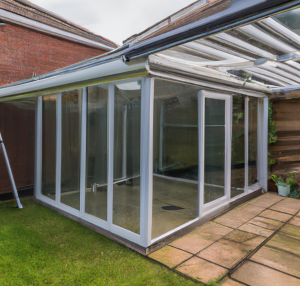
Furthermore, the sloped roof of a conservatory can make it difficult to hang fans or light fixtures, and the size limitations may not be ideal for larger conservatory projects.
Privacy is another concern as glass takes precedence in conservatory design, and neighbors and passers-by may be able to see inside. Lastly, conservatories can be susceptible to damage from heavy winds and rain.
Does a lean-to conservatory add value?
Adding a lean-to conservatory to your home can be a cost-effective way to increase its value and desirability to potential buyers. Compared to an extension, a conservatory is a more affordable and less disruptive option that can boost your home’s value by at least 5%.
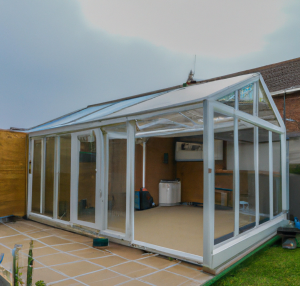
However, the actual value it adds can depend on various factors, such as the materials and size of the conservatory, so it’s important to consider these aspects when planning your project. Ultimately, a well-built and well-designed lean-to conservatory can be an attractive feature that adds value to your home.







